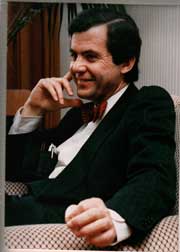 Reviewed by Ambassdor Mark Palmer
Reviewed by Ambassdor Mark Palmer
Frederick Kempe, Berlin 1961, Putnam: N.Y., 2011, ISBN: 9781101505625, 608 pp., $29.95 (hardcover), $16.00 (paperback).
The 50th anniversary of the erection of the Berlin Wall has brought forth a rush of articles, statements and reflections on its significance — and one very good book. Former Wall Street Journal Europe editor and current Atlantic Council President, Frederick Kempe, has written a spellbinder in his recently published Berlin 1961.
The Cuban Missile crisis a year later, which Kempe and other observers find was in part caused by the Kennedy Administration’s handling of the Berlin Wall, is the subject of seemingly endless books and movies. Despite Khrushchev’s view in his memoirs that Berlin was “the most dangerous place on earth,” the diplomacy behind the Berlin Wall has received far less attention.
As Kempe himself states, “it struck me that none of these books had put together all the pieces that had contributed to the historic occurrences around Berlin in 1961. My goal was to produce a readable, authoritative narrative for both the expert and the general reader that would investigate all the available historical accounts and combine those with the more recently declassified materials in the United States, Germany and Russia.”
From a parochial Foreign Service viewpoint, Berlin 1961 is particularly notable for the prominent roles which Kempe ascribes to distinguished American Foreign Service officers: Tommy Thompson, Chip Bohlen, Allan Lightner, Marty Hillenbrand, Foy Kohler, George Kennan. Their extraordinary closeness to Khrushchev and Kennedy, their understanding of things Soviet, German and — importantly — American, and their willingness to fight for what they believed to be in our best interest, even in the face of strong crossfire, are on prominent display.
Equally intriguing is that these FSOs (and others) split over their recommendations to Kennedy on how to handle Khrushchev. As Kempe notes: “Kennedy saw his administration separating into two camps. The first was becoming known as the Hard-Liners on Berlin and while the other had been disparagingly labeled by the hawks in the room as the SLOBs, or the Soft-Liners on Berlin. The hardliners included Acheson and Assistant Secretary of State Foy Kohler, the whole of the German desk at the State Department, Assistant Secretary of Defense Paul Nitze, and more often than not the Joint Chiefs of Staff at the Pentagon and Vice President Johnson. The soft-liners disliked the acronym that described them, which they saw as an attempt to discredit their greater willingness to find a negotiated Berlin solution. They were a formidable group and were closer personally to Kennedy: Thompson, Bohlen, Schlesinger, Kissinger, McNamara and Bundy.”
The scene had been set first by the Bay of Pigs and then by the first meeting of the two leaders at their Vienna Summit. As Ambassador Thompson wrote to the President before Vienna: “Discussion of the German problem will be the main point of the exercise so far as Khrushchev is concerned. It would be at that meeting or shortly thereafter that the Soviet leader would set his course on Berlin”. Kempe then notes: “With uncanny clairvoyance, Thompson added: ‘If we expect the Soviets to leave the Berlin problem as is, then we must at least expect the East Germans to seal off their sector boundary in order to stop what they must consider the intolerable continuation of the refugee flow through Berlin.’”
The tension at the Vienna Summit and thereafter over Berlin is well described by Kennedy himself in a post-Vienna interview with The New York Times journalist Scotty Reston: “Because of the Bay of Pigs, Khrushchev thought that anyone who was so young and inexperienced as to get into that mess could be taken. And anyone who got into it and didn’t see it through had no guts. So he just beat the hell out of me….I’ve got a terrible problem.”
Sensing weakness, Khrushchev poured on the pressure. He began to openly threaten a nuclear attack on the West if we did not weaken our stance on Berlin. For example, he wrote to Prime Minister Macmillan: “Why should two hundred million people die for two million Berliners”.
In the face of this pressure, Kennedy largely sided with the “SLOBs”. He began in speeches and messages to the Soviets to distinguish between East and West Berlin — despite allied agreements treating the city as a whole and a consistent, careful and conscious use of only the word “Berlin” by all previous administrations. In a speech to the American people, he argued that: “The immediate threat to free men is in West Berlin”. The message to Khrushchev was clear. He proceeded to build the wall and Kennedy did nothing to stop him.
As The Economist recently recalled, Kennedy said at the time: “A wall is a hell of a lot better than a war”. In Berlin 1961 Kempe argues strongly that we need not have ended up facing that stark choice, that Kennedy’s first year performance in foreign policy from the Bay of Pigs through the Vienna Summit to the Berlin Wall was a series of fiascos. At the same time Kempe’s objectivity is impressive. He provides a rich and detailed fabric for the complexities facing Kennedy, and facing Khrushchev as well.
The Soviet side of this dynamic is particularly interesting for this Kremlinologist. Kempe’s accounts of the pressures Khrushchev faced from Mao and Ulbricht, and internally from some members of his own Politburo, are absolutely riveting. It is good to remember that Khrushchev was ousted just five years later by his own colleagues. But his eventual ouster was in substantial measure due to his colleagues’ concern over Khrushchev’s erratic behavior, his adventurism in foreign policy. It is tempting to wonder whether his Politburo colleagues would have been more comfortable had Khrushchev been prevented by Kennedy’s strength from ever going to the brink in Berlin. Kempe clearly believes that Kennedy could and should have done more to earn Khrushchev’s respect and caution over the preceding months, to prevent Khrushchev from ever getting to the point of giving in to the pressures from others, pressures which had been there for several years, and if it came to that, to interfere with the actual construction.
One can speculate endlessly about whether the options the Hard-Liners (and Kempe) favored would have led to war with the Soviet Union. Another less catastrophic but still damaging outcome would have been a possible loss of Berlin as a whole, with the Soviets sealing off and taking the entire city. This would have been a huge loss ofblow to the prestige and power for of the United States, possibly causing the West Germans to become neutral between NATO and the Soviet Union. We were certainly at a severe disadvantage on the ground from a purely military point of view. My one criticism of his book is that Kempe does not sufficiently set forth the potential moves and counter-moves which could have ensued from a physical intervention by the United States. He does not really play out this dynamic.
Fifty years later we do know with a fair degree of certainty what the consequences of successfully halting the erection of the Berlin Wall in 1961 would have been. It was precisely the hemorrhaging of East Germans in 1989 which brought down the Berlin Wall and contributed mightily to the tectonic shift in the overall geostrategic situation in favor of the West and freedom for literally dozens of nations. As The Economist recently reminded us: “By August 1961 around 3,000 citizens were deserting the German Democratic Republic every day, mostly via Berlin and there was a danger of economic collapse”. The Cold War might have ended three decades sooner if we had given greater weight to the willingness and ability of the peoples of Central Europe to stand up to the Soviet occupiers — a willingness demonstrated in 1953 in East Germany itself, in Hungary in 1956 and so forth.
I find three lessons for us today.
First, despite the failure of the Vienna Summit, of Bobby Kennedy’s back channel dealings with Soviet intelligence officer Georgi Bolshakov, and the many front channel efforts by Ambassador Thompson, and President Kennedy himself, we should not conclude that diplomatic engagement with hostile dictators is a mistake. On the contrary, it is clear from this history that engagement is essential. But it must be based on a realistic understanding of the opponents’ objectives and their strengths and weaknesses. Indeed one could argue that our embassy in Moscow provided key insights. Our lack of a regular diplomatic dialogue with Iran’s and North Korea’s dictators, with these major threats to peace and to their own peoples, our failure even to have embassies in Tehran and Pyongyang today, is a signal weakness.
Next, there is no substitute for strength in dealing with dictators, whose own power at home and abroad is based on the threat and use of force. As Kennedy recognized, Khrushchev had concluded that Kennedy was weak, that the United States would not act to prevent the erection of the Wall. He subsequently tried his hand again by stationing nuclear-armed missiles in Cuba. This time Kennedy stood his ground and a far different outcome was achieved.
Finally, the contrast between Berlin, 1961 and Berlin, 1989 is instructive regarding people power. Conventional wisdom among American and Western “experts’” on dictatorships is that they are immutable, that their peoples do not have the power to oust them. Despite sixty democratic revolutions across the globe over the past four decades, the “experts” continue to underestimate the potential for democratic change from below and with the support of the democratic world. We saw this most recently in the months before the Arab Spring and we see it still in views of the potential for change from below in China, North Korea, and in the some forty other still Not Free countries.![]()

In the Foreign Service, Ambassador Mark Palmer specialized and served in communist countries, was principal speechwriter for Secretary Kissinger and conceived and wrote President Reagan’s speech to the British Parliament in 1982 which led to the establishment of the National Endowment for Democracy, and was Deputy Assistant Secretary of State for the Soviet Union and Eastern Europe and then U.S. Ambassador to Hungary during the crucial period for bringing down Europe’s communist dictators. After the fall of the Berlin Wall, Ambassador Palmer became an investor in the former communist countries, including establishing the first national independent commercial television stations in six countries, and building a major real estate complex at Checkpoint Charlie in Berlin. He is President of Capital Development Company LLC, which invests in the United States and overseas. He is the author of “Breaking the Real Axis of Evil: How to Oust the World’s Last Dictators by 2025”, whose policy recommendations form the basis for the ADVANCE Democracy Act of 2007.
